Address: Langfords | Friars Hill Rd | St. John's. Antigua | Email: dsjbchancery@gmail.com | Tel: 1-268-461-1135
SEEDS OF FAITH: Scattered and Sown
The History of Catholicism in Antigua
Even though the first Europeans to visit these shores named Antigua after the Cathedral of Santa de Maria in Spain, the establishment of the Catholic Church in Antigua was born out of much travail and persistence, and did not take place until several hundred years later. The birth of the church was a post-emancipation experience and came about shortly after some 2500 Portuguese, most of whom came from Madeira as indentured immigrants and merchants. Prior to their arrival, there was a handful of Irish Catholics on the island, but their numbers restricted them to private house worship or to joining soldiers out at Shirley Heights when there was a visiting priest.
The historical records of Bishop Morris paint a clear picture.
“By 1859, over two thousand Portuguese immigrants had arrived from Madeira, swelling the ranks of the few Irish Catholics on the island who had been visited infrequently by a priest from the neighbouring islands. Countess Masterson, a Catholic and owner of Blake’s’ Estate, was always close to, and very much in touch with the social conditions of the new settlers that prevailed on the island. Ever since the early 1850’s, Countess Masterson persistently wrote to the bishops of Roseau, apprising them of the plight of the newly arrived Catholics. She appealed to the bishops in Roseau to send them a priest and to establish a parish to minister to the pastoral needs of the new Catholic population. ………… but the first two Bishops, Monaghan and Le Vesque, were unable to find priests to send to Antigua. Montserrat and St. Kitts and some of the other islands were already being served by parish priests. The third Bishop of Roseau, Bishop Poirier, in 1859, was successful in securing the service of a Father Ryan. He wrote Countess Masterson, announcing that by the end of September 1859 a parish priest would be arriving in Antigua. (Diocese records cited by Bishop Morris – 1924).”
The first Roman Catholic chapel was set up in a two-storied house on lower Redcliffe Street; the chapel was on the first floor and Fr. Ryan lodged on the upper floor. In 1862, one year after Fr. Ryan’s left Antigua, his successor, Fr. Van Os had the chapel relocated to lower North Street near the Point. In 1862, a few months before Fr. Van Os moved on, he invited Bishop Poirier to a grand confirmation ceremony for 72 candidates. This was to be the very first visit by a Catholic bishop. It was during this visit that discussions began with leading church members about purchasing a piece of land for the purpose of building a church. The Church continued to grow its numbers being increased significantly by a new wave of immigrants from Lebanon and Syria. The Portuguese community introduced the practice of 5.00 am Christmas novena, a practice which has lasted through the years.
In 1864 Fr. Dupuy, a Belgian, took over the reins of the new parish. He had the chapel relocated further east on North Street. It was during his tenure as parish priest that the Church began to acquire and build church property including: the first school building and an orphanage. The school was operated by nuns from the Order of the Faithful Virgin. A small chapel was also opened in Parham to serve persons living in the northeast portion of the island.
In 1869 the first Catholic Church was erected at the corner of Church and East Streets under the stewardship of Fr. Gagneux. However, due to its small size and the discovery of some structural weaknesses, the Church had to be rebuilt in 1909 under the leadership of Fr. Rabaey, one of the Redemptorist priests who had been serving the island from 1903.
In 1933, a group of nuns from the order of the Immaculate Heart of Mary (ICM) arrived on island to re-establish the Convent High School and the Catholic Primary School (a.k.a Poor Convent), and in 1958 a group of religious brothers from the teaching apostolate arrived to establish and operate the St. Joseph’s Academy, an institution for boys. Brothers Wakeham, Walsh and Armstrong were among the pioneers. Among the nuns who taught here were: Sisters Lutgarda, Leandra, Bosco, Albina, Ambrosina, Joan and James. All throughout this period, Antigua fell under the jurisdiction of the Diocese of Roseau, Dominica. Bishop Boghaert and Bishop Demets were among two of the bishops who served in that diocese.
Added to the roster of SJA’s staff was Bro. Edward Lawlor who would go on to become ordained for the Diocese as Fr. Edward Lawlor and to serve in the diocese until his demise in 2019.
As was typical in much of this pre-Vatican II era, the laity had little in way of official roles in the Church. However, it was a time of flourishing for several groups including the Social League of Catholic Women, the Legion of Mary, Sacred Heart Society, Eucharistic Crusaders, Holy Name Society, Young Christian Workers, Society of St. Vincent de Paul, Sunday schools, and church choirs. There was a credit union in operation, and scores of men and women, from all walks of life, who contributed to keeping the spirit of service alive. Novenas, pilgrimages, days of retreat, missions, and religious festivals were all very much a part of parish activity and were balanced with various outreach activities.
Over many years, several other churches/chapels were built to accommodate Catholics living outside the city of St. Johns. These included: Our Lady of Perpetual Help in Tyrells, Our Lady’s Church (Ovals); St. Anthony’s Church (Potters); St. Francis of Assisi (Villa); Church of St. Martin de Porres in Parham. To the glory of God, many generous parishioners have contributed time, talent and treasure to build up these communities. The various church organists and choir directors, then and today, including Eileen Mills at Ovals, Mrs. Benjamin at Tyrells, Joe Lewis, John Shoul Jr., and Foster Hill at St. Joseph’s, Sylvia Laurent, Alvin Langley, and Jean Mathurin, have given of their talents in exemplary ways.
1971 – 1977
By the early 1970 the register of Catholics in Antigua numbered approximately 5,000. The Vatican took a decision to create the new diocese of St. John’s, Antigua which would also have responsibility for St. Kitts and Nevis, Montserrat, Anguilla, Tortola and Virgin Gorda. Appointed to head the diocese was Dominican-born Joseph Oliver Bowers, a member of the Society of Divine Word Missionaries, who in 1953 had been ordained as the first bishop of Accra, Gold Coast (now Ghana). Though Bishop Bowers was born in Massacre, his roots were strong in both Antigua and Ghana.
The new diocese faced many challenges in areas of finances, discrimination, disunity within the Catholic community, housing for clergy, and staffing levels. Bishop sought to resolve some of these issues by entering into an arrangement with the Divine Word Missionaries who accepted responsibility for staffing the diocese. In 1977, three extra-ordinary minister of the Eucharist werecommissioned. Along with the Redemptorists, Christian Brothers, and ICM nuns who were already working in the diocese, Le Coeur de Jesu (C.J.) Sisters were recruited to serve in the Catholic Schools in St. Kitts. The first Life in the Seminar was conducted, and the Catholic Charismatic Renewal Movement took root in Antigua. Its offspring was grafting into the small prayer group which had already been meeting weekly at Our Lady’s Church.
Bishop Bowers attempted in practical ways to improve and empower members of the society through sourcing funding in support of an agricultural co-operative, and by establishing a program for young single mothers to improve their skills and to find ways to make a livelihood for themselves and offspring. The program provided tuition in nutrition, spiritual life, home economics and sewing. Sr. Evalina John-Phillip from Dominica led the program at the old ‘Villa Maria’ on Stapleton Lane – the former property of Miss Marie Lake.
It was also during this period that Bishop encouraged the formation of the Catholic Women’s Organization as a sort of replacement for the Social League whose activities had begun to taper off.
1978-1983
The young diocese continued to experience some growing pains during this period, even though the percentage of Catholics remained more or less stationary at between 8% – 10% of the population. The arrival of two additional SVD priests, Frs. Finnegan and Power, gave the diocese a complement of eight SVD priests. By this time, the number of Redemptorists had declined as they sought to have members reconnect with their own communities.
In 1981, the year of Antigua and Barbuda’s independence, Bishop Bowers relinquished leadership and retired to the islands of Nevis and Dominica before moving permanently back to Ghana where he died in 2012 at the age of 102 years. His remains are buried in the Holy Spirit Cathedral in Adabracka, Accra, Ghana. His replacement, Rev. Donald J. Reece, a native of Jamaica was ordained and installed as Bishop on October 8, 1981 as Bishop of the Diocese of St. John’s-Basseterre reflecting the new status of St. Kitts and as the Immaculate Conception church as the co-cathedral.
One of Bishop Reece’s visions was the bringing of the various communities together to worship in a common space and an improvement in harmony and community spirit. This vision of a common space was realized after six years, when, after considerable energy, planning, and raising of resources, the Holy Family Cathedral was blessed and opened on January 20 of 1987. The shortage of priests, however, remained as one of the major challenges facing the diocese. Fr. Arnold Francis, one of two Antiguans ordained to the priesthood over this period, later served at the Holy Family Cathedral. The other priest, Fr. Glanville Joseph served as a Redemptorist in the island of Montserrat.
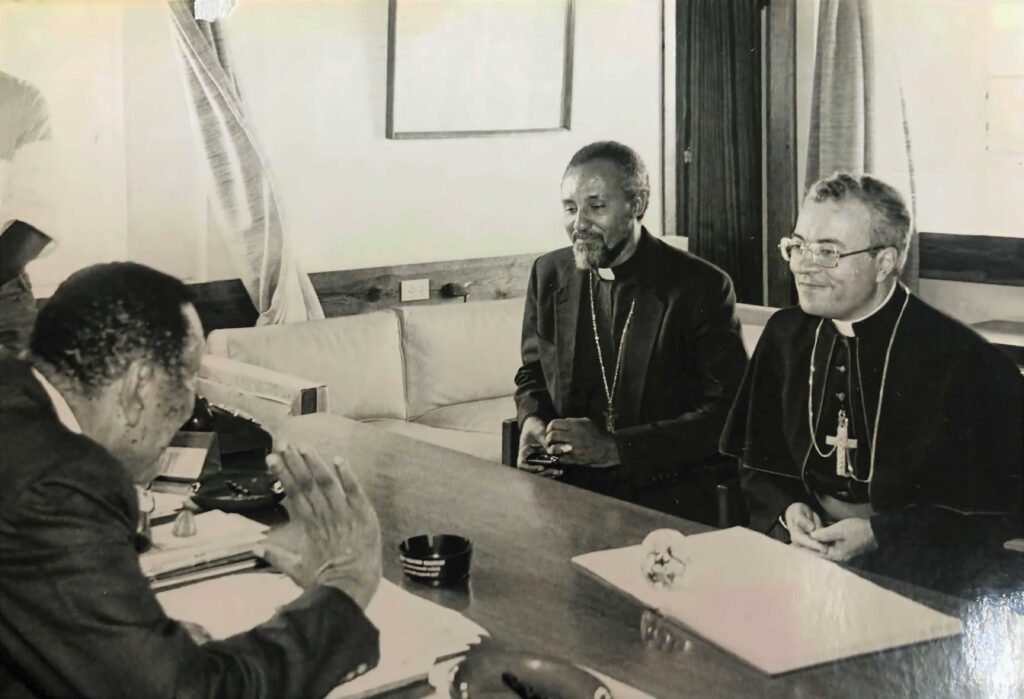
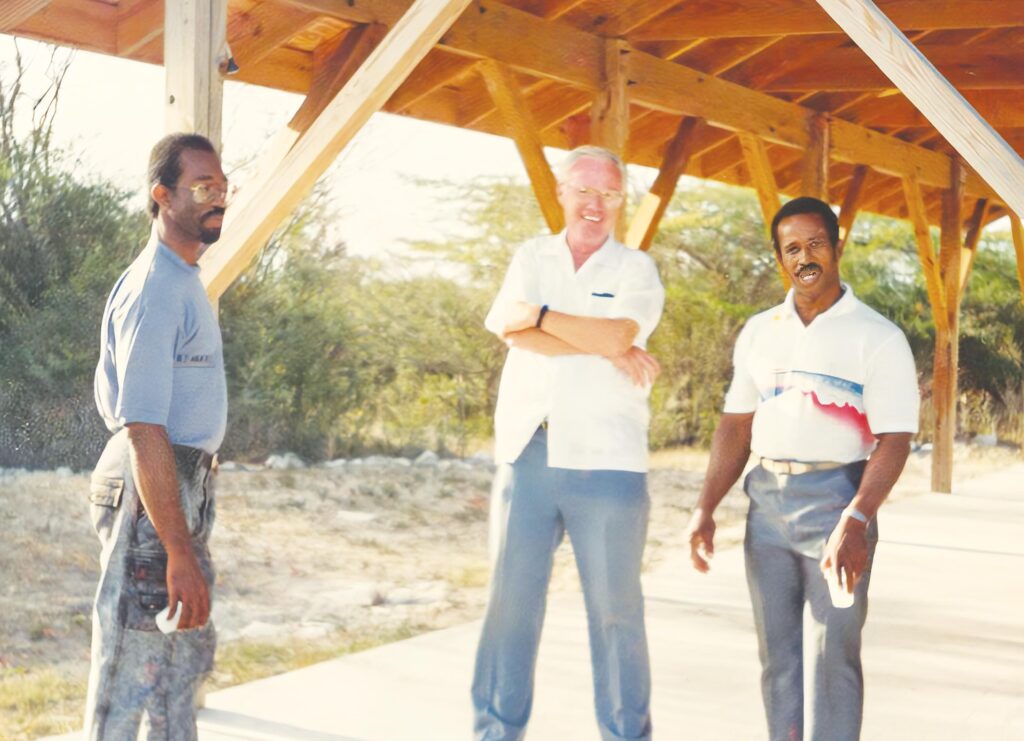
During this period, the diocese experienced its third wave of immigrants – Hispanics from the Dominican Republic occasioning the need for Spanish-speaking pastoral workers. This role was eventually filled over time by Frs. Mellert and Lapur and now for the last few years by Fr. Robert Ratajczak.
Bishop Reece placed much emphasis on catechesis and the development of catechetical programmes. Training of lay persons commenced with greater focus. The objective was to train one or two persons to be part of a Catechetical Commission which would in turn assist with the planning of programmes for parishes and schools throughout the Diocese.
1983-1988
During this period there was a marked effort to strengthen some of the existing church groups and to engage in meeting more of the pastoral needs. The Sisters of St. Martha (C.S.M.) and the Franciscan Sisters (O.S.F.) were added to the missionaries serving in Antigua and the Lay Apostolate Organization now included the Cursillo Movement, The Sacred Heart Society, the Charismatic Renewal Prayer Group, and Basic Ecclesial Communities (B.E.C.). This was also the era for Catholic youth development. The Diocesan Youth Ministry’s Office was established. The strengthening of the catechetical, sacramental and religious education programmes was made a priority and placed under the co-ordination of Chief Catechist, Mrs. Morvette Thomas. In keeping with this trust, the St. Vincent de Paul (S.S.V.P.)/Caritas Internationalis conducted workshops and seminars on the social teachings of the Church. Resulting from this interaction was the sponsorship by the Society of the Good Shepherd Home for disadvantaged and abused girls.
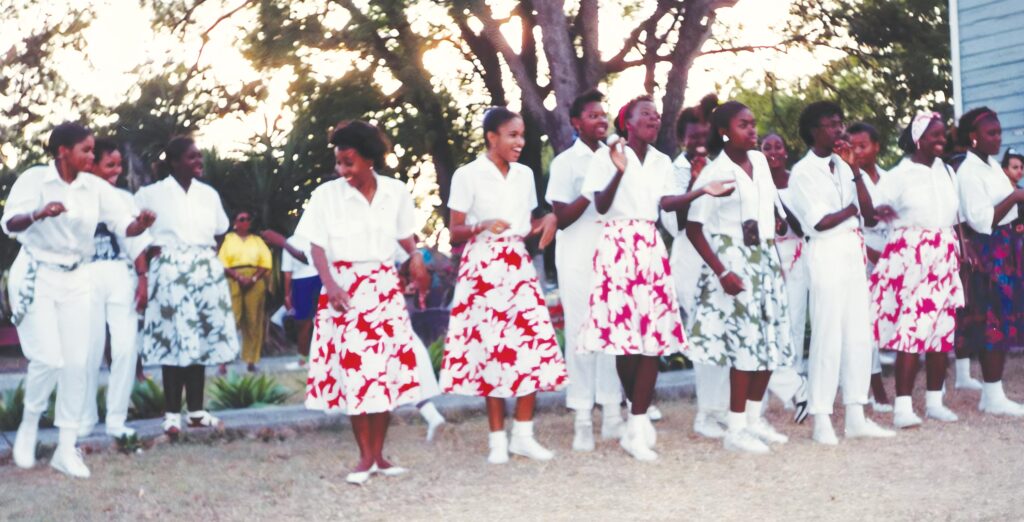
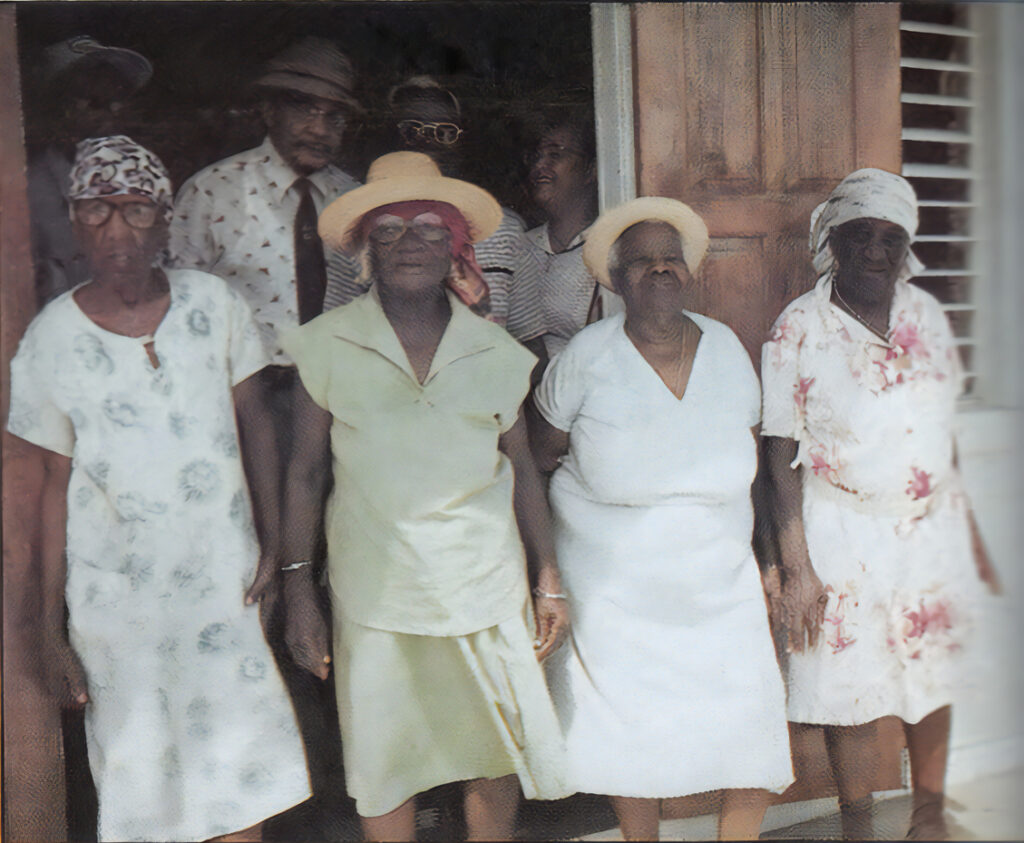
1988-1993
With Bishop Reece at the helm, the Church in Antigua continued to face and overcome its normal share of challenges. Catholic Christian formation was paramount. Much emphasis was placed on programmes for the preparation of sacraments – specifically baptism, first communion and confirmation. Programs were discussed and projects put in place in connection with the Rite of Christian Initiation of Adults (RCIA); Basic Ecclesial Communities (B.E.C); the ‘caribbeanisation’ of the liturgy, retreats and parish missions, biennial liturgy workshops, the education of pastoral counsellors and early childhood educators, the establishment of Catholic Teachers’ Associations, and a Catholic Education Council. Visitation programs to shut-in by ministers of Holy Communion, a ministry to prisoners, systematic programming for youth in the Diocese, and evening school for Hispanics were just some of the ways through which the Diocese embraced its mission. During this period Fr. Gerard Critch was ordained for the diocese.
1993-2001
As the Diocese prepared to enter the twenty-first century, efforts were made to more deeply embed the faith in the faithful for whom the everyday reality has been to live ‘Catholic’ within a predominantly Protestant cultural environment. The Church in Antigua continued to search for new, creative ways to evangelize. New tools used for communication included the Internet and Catholic Radio (89.7 FM). Having secured the services of a full time Spanish speaking priest and a Holy Spirit sister, more pastor work was undertaken with the Hispanic community.
The I.C.M. Sisters and the Christian Brothers departed Antigua during this period, making it necessary to recruit lay persons for all teaching and administrative positions in two of the three Catholic schools. The Presentation Sisters of the B.V.M. still formed part of the staff at St. John’s Catholic Primary School with Sr. Paulette Nugent as principal.
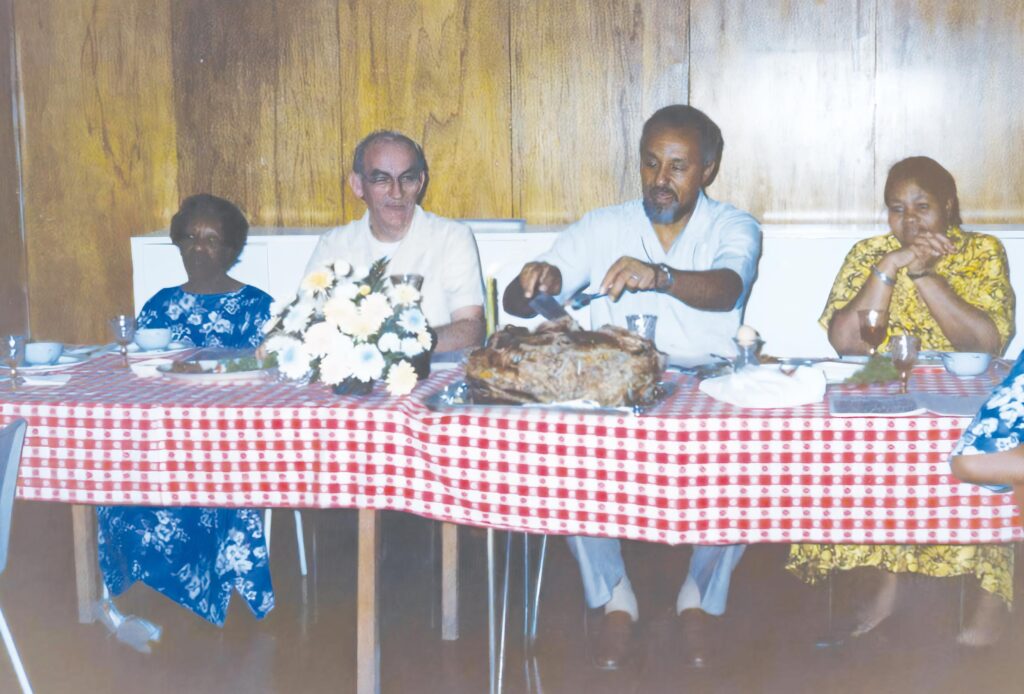
The empowerment of young people was especially heightened as several young men and women were given the opportunity to study abroad with the objective of having them return to serve in their respective parishes, thereby re-energizing and bringing enthusiasm to young parishioners.
The Couples for Christ ministry was introduced to Antigua, and on October 4, 1996, the diocese was enriched by the lives of four married men who were ordained to the permanent diaconate: Rev. Deacons Llewellyn Dyer, Whitfield Aska, Pershing Waldron Snr., and St. Clair Francis.
This period was one of vibrancy for the Church and for liturgy. It was during these years that the Church in Antigua experienced a burst of energy brought to it by the Vitus Mas Troupe, the Holy Family Cathedral Steel Orchestra, liturgical dancers, stilt walkers, the drama club, public speaking group, and the voices of the youth and adult choirs. Ms Keva Margetson was one of the several persons instrumental in bringing this energy to the fore.
2001-Present
The twenty-first century ushered in several changes in the Church in Antigua and by extension the Diocese of St. John’s-Basseterre. Efforts to construct an out-station at Donovans to serve that community became a serious financial challenge. The structure, though in an advanced stage of construction, has remained incomplete for more than a decade.
In 2002, on lands generously donated by Mrs. Alice Francis, the Mount Tabor Retreat Centre was constructed. Located in the village of John Hughes, the main building along with the cottage can accommodate 26 overnighting guests. Its first Retreat Director was Fr. Frank Power and he was succeeded by Sr. Mary-Jo McKeefry.
After twenty-six years as Bishop of the Diocese, Bishop Reece returned to Jamaica as Coadjutor Archbishop of Kingston. There followed a four year period when there was no resident bishop on the island. During this time, Bishop Gabriel Malzaire of Roseau was appointed Apostolic Administrator and made regular visits to the island. However, on February 8, 2012, Monsignor Kenneth Richards of Jamaica was duly ordained as the third bishop of St. John’s (the second of St. John’s-Basseterre). Bishop Richards appointed Rev. Fr. Pierre Tevi-Benissan SVD as his Vicar General.

These last twenty-five or so years were indeed a transitional period for the Church. It took the church from a neo-colonial society to an assertive post-Independence community of pilgrims, sharing and living the faith of our Fathers under the guiding hands of our shepherds: Bowers, Reece, Richards and now the shepherd for these times, in the person of Bishop Robert Llanos, the fourth bishop of the Diocese who has brought the Diocese and us to the fiftieth year mark in our spiritual journey. The two parishes in Antigua, Holy Family and Our Lady of Perpetual Help, have been enriched by the ordination of two priests for the Diocese: Fr. A. George Williams in 2004 and Fr. Peter Kinuthia Mwaura in 2016, and with the addition of five permanent deacons in 2019.
